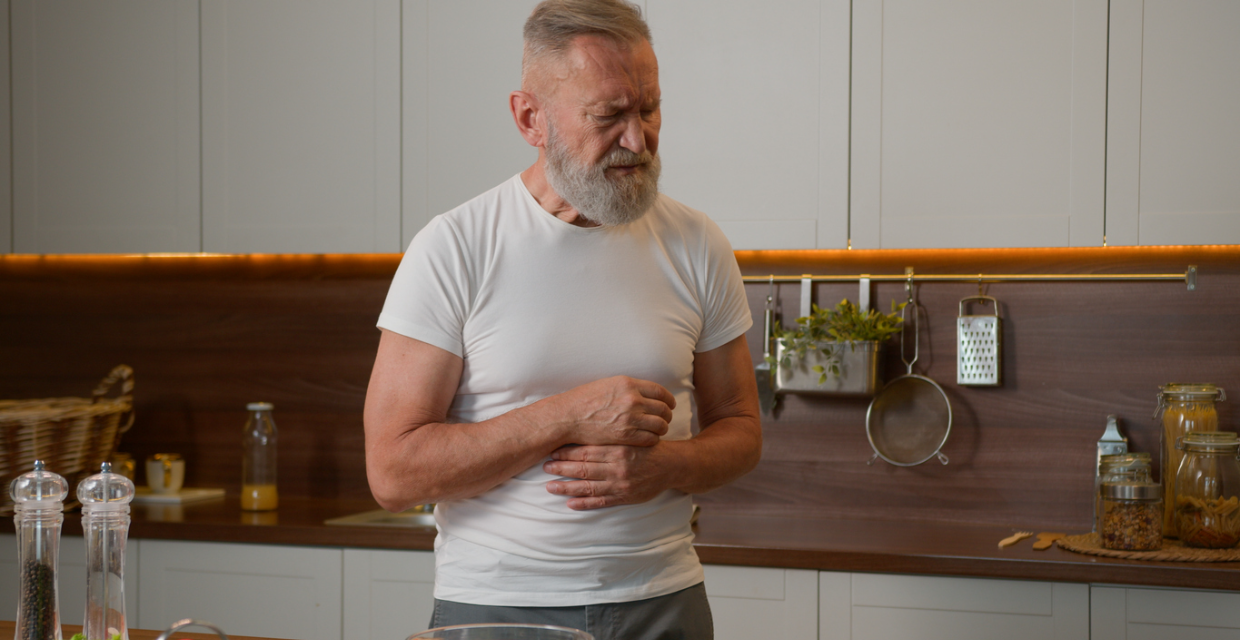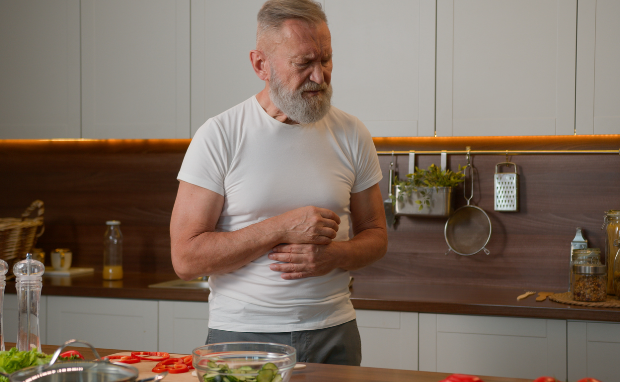Key Points
- Gastritis causes burning stomach pain, bloating, and gnawing aches due to inflammation of the stomach lining from bacteria, medications, or stress
- Avoid trigger foods like spicy dishes, caffeine, alcohol, and fried foods while choosing gentle options like oatmeal, lean proteins, and cooked vegetables
- Use gentle cooking methods like baking and steaming, eat smaller, more frequent meals, and manage stress to support stomach healing
Dealing with gastritis can be incredibly frustrating. The burning, gnawing ache, and bloating can turn eating into a source of anxiety. After all, it’s hard to plan your days when you’re constantly worrying about what foods to eat and how to prevent painful flare-ups.
Plus, even if you know what foods to avoid with gastritis, it’s hard to put a meal plan together while juggling the rest of your life.
Here’s a 7-day meal plan for gastritis to help you avoid triggers and get the nutrition you need.
What is gastritis?
Gastritis is inflammation of the stomach lining, the protective barrier that shields your stomach from acids, enzymes, and microbes. When the stomach lining gets inflamed, it can get red, swollen, and painful, leading to the symptoms of gastritis.
Gastritis is caused by many factors, including:
- H. pylori bacterial infection
- Long-term use of medication like ibuprofen or aspirin
- Excessive alcohol use
- Chronic stress
- Certain autoimmune conditions like Hashimoto’s disease, Crohn’s disease, and more
There are two types of gastritis: acute and chronic.
Acute gastritis vs. chronic gastritis
Acute gastritis is a sudden, temporary inflammation of the stomach lining that develops quickly and typically lasts 2-10 days. It's usually caused by irritants like NSAIDs (pain relievers), alcohol, stress, or infections. It causes a sharp, intense pain that comes and goes.
Chronic gastritis is long-term, persistent inflammation that develops gradually over weeks to years. It's commonly caused by H. pylori bacteria or autoimmune conditions and often results in a dull, persistent ache or may have no symptoms at all. Without treatment, chronic gastritis can lead to complications like ulcers or stomach cancer.
The key difference is that acute gastritis is short-term and intense, while chronic gastritis is long-term and often silent.
What’s the best gastritis treatment?
The thing about treating gastritis is that it really depends on what's causing your stomach lining to get inflamed in the first place.
Gia Eapen, MD, says, “If you have an H. pylori infection, you may get antibiotics for 1-2 weeks. If your gastritis is from overusing ibuprofen or NSAIDs, you may get acid-reducing meds like proton pump inhibitors or antacids.”
But what you eat also makes a big difference in how you feel.
Remember, always consult a healthcare provider if you're experiencing symptoms of gastritis for proper diagnosis and treatment.
Gastritis diet: What foods to eat and what to avoid?
Before we dive into the meal plan, let's cover the basics.
Registered Dietitian Rita Faycurry, RD, says, “You'll want to build your meals around gentle, nutrient-dense foods while avoiding common triggers. Keep in mind that everyone's different. Some foods may be fine for you, while others cause problems. The best gastritis diet is tailored to your unique triggers and what makes your stomach feel good.”
Common trigger foods to avoid (or limit)
Here are some common trigger foods for gastritis:
- Spicy foods: Hot peppers, chili powder, and hot sauce
- Acidic foods: Tomatoes, citrus fruits (oranges, lemons, grapefruit), pineapple, lemon, lime, and vinegar
- Caffeine: Coffee and coffee drinks, black tea, green tea, iced tea, caffeinated sodas, and energy drinks. Chocolate also has caffeine and may be a trigger for some people. Avoid caffeine pills during an acute gastritis flare-up
- Fried food: Fried chicken, fried fish, burgers, fries, chicken wings, onion rings, chicken nuggets, hash browns, and more
- Full-fat dairy: Full-fat milk, butter, ghee, ice cream, lots of cheese, creamy sauces, and puddings
- Nuts: Nuts and nut butters are rich in fat and may be a problem for some people with gastritis
- Alcohol: When gastritis is caused by alcohol, it’s called ‘alcoholic gastritis.’ The first step in treating alcoholic gastritis is to avoid alcohol intake
- Carbonated drinks: Large amounts of fizzy drinks may worsen gastritis symptoms, especially if they have a high sugar and caffeine content
- Ultraprocessed foods: These include packaged foods such as chips, crackers, sugary and highly refined cereals, deli meats, hot dogs, frozen pizza, instant noodles, packaged cookies and pastries, and processed cheeses. These “foods” often contain high levels of salt, fat, and preservatives that can contribute to inflammation
Foods to eat
Gastritis is not all about what not to eat; while it may be a struggle, there are anti-inflammatory, gastritis-friendly options for you, including:
- Low-acid fruits: Bananas, apples, berries, melons (cantaloupe, honeydew), pears, and applesauce are great choices
- Cooked vegetables: Steamed or roasted vegetables are easier to digest than raw ones, including root vegetables like carrots and sweet potatoes, leafy greens like spinach, kale, and arugula, squash family vegetables like zucchini and squash, other vegetables like peas, green beans, asparagus, broccoli, bell peppers (without seeds), artichoke, celery, and fennel, plus flavorful additions like onions and garlic
- Lean proteins: Skinless chicken or turkey (baked, grilled, or steamed), fish, eggs, and tofu are excellent sources of protein that may be well-tolerated
- Whole grains: Oatmeal, rice, and toast (from whole wheat or white bread, depending on your tolerance) can be very soothing
- Healthy fats (in moderation): Small amounts of avocado, olive oil, and nuts or seeds can be incorporated
- Probiotic-rich foods: Low-fat yogurt contains beneficial bacteria that can support a healthy gut and may even help inhibit the growth of H. pylori
The good news is that if you become friends with certain spices and seasonings, you can add a burst of flavor and interest to your meals without triggering gastritis symptoms.
Here are some spices and seasonings that may work for people with gastritis:
- Ginger
- Cinnamon
- Garlic and garlic powder
- Cumin and cumin powder
- Herbs like basil, oregano, parsley, sage, tarragon, cilantro, rosemary
- Spices used in Asian and South Asian meals. These include turmeric, cardamom, fenugreek, fennel, lemongrass, and miso. Note: Miso is made from soybeans, so avoid if you have a soy allergy
Disclaimer: This list includes common herbs and seasonings that many people with gastritis can typically tolerate, but gastritis triggers are highly personal and vary from person to person.
“It's best to introduce new seasonings slowly, one at a time, and keep track of how they make you feel,” cautions Faycurry, RD. “Always consult a healthcare provider if you experience gastritis symptoms or digestive discomfort for proper diagnosis. Consider consulting a registered dietitian for personalized guidance and support on what to eat and avoid with gastritis, as well as meal planning and more.”
Easy 7-day gastritis meal plan
This plan is just a starting point: mix and match meals based on what's in your fridge, your food preferences, and what sounds good to you!
The point is to stick with gentle, low-acid, low-fat foods. And remember to drink plenty of water throughout the day.
Day 1
Breakfast: Oatmeal with banana. Oatmeal made with water or almond milk, topped with a sliced banana, and sprinkled with cinnamon. If you cannot tolerate almond milk, consider using coconut milk or mixing just water with applesauce.
Lunch: Baked chicken breast with steamed veggies. Season a chicken breast with gentle herbs like thyme and parsley and bake. Serve with a side of steamed carrots and a small baked potato topped with a dollop of low-fat yogurt.
Dinner: One-pan Asian tofu-broccoli coconut curry. Stir-fry cubed tofu with onions (or the white part of spring onions), garlic, ginger, a pinch of turmeric, and steamed broccoli florets. Add in coconut milk, add salt, and serve over steamed brown rice. Optional: garnish with the greens of spring onions or cilantro.
Snacks: A cup of low-fat yogurt topped with diced pear, a handful of almonds.
Day 2
Breakfast: Loaded veggie scramble. Sauté grated carrots, grated zucchini, and minced garlic in olive oil for a few minutes, then add the spinach and cook until wilted. Beat eggs with dried basil, oregano, and salt. Pour over vegetables and gently scramble on low heat. Serve with whole-wheat toast and a side of sliced banana or berries.
Lunch: Chicken salad: A simple chicken salad made with shredded baked chicken breast, mashed avocado instead of mayonnaise, and steamed veggies like carrots and celery. Season with garlic powder and onion powder. Sprinkle a handful of pumpkin seeds or sunflower seeds for crunch (if you can tolerate it).
Dinner: Turkey meatballs in broth with pasta. Mix ground turkey with quick-cooking oats, minced garlic, oregano, and basil. Form into meatballs and bake until cooked through. Simmer meatballs in a simple broth-based sauce made with low-sodium vegetable broth, garlic powder, and fresh basil. Serve over whole wheat pasta and garnish with fresh parsley.
Snacks: Banana with almond butter, whole grain crackers with mashed avocado.
Day 3
Breakfast: Boiled egg with a smoothie. Blend frozen bananas, frozen berries, and some oat milk for a delicious breakfast smoothie. Eat with a boiled egg to get your protein and dose of healthy fats.
Lunch: Quinoa bowl. Cook quinoa in low-sodium chicken broth for extra flavor. Season chicken breast with fresh basil, oregano, and garlic powder, then bake until cooked through and shred. Top quinoa with steamed broccoli florets, roasted sweet potato cubes, and seasoned shredded chicken. Drizzle with olive oil mixed with fresh basil and garlic powder or a simple tahini-yogurt sauce made with plain low-fat yogurt, tahini, and a pinch of ginger.
Dinner: Baked salmon with mushrooms and rice. Season the salmon fillet with fresh rosemary, oregano, and garlic powder, then bake until it is cooked through. Sauté sliced button mushrooms in olive oil with fresh basil until tender. Serve salmon over steamed brown rice, topped with the sautéed mushrooms. Optional: add a side of steamed green beans seasoned with garlic powder for a boost of fiber.
Snacks: Sliced pear with almond butter and a drizzle of honey, whole grain toast topped with low-fat cottage cheese and sliced melon.
Day 4
Breakfast: Quinoa porridge with apple and cinnamon. Cook the quinoa in low-fat milk or almond milk until it becomes creamy. Top with diced ripe apple and a sprinkle of cinnamon. Add a drizzle of honey if tolerated.
Lunch: Herb-crusted cod with mashed sweet potato. Season a cod fillet with dried dill, parsley, and a pinch of garlic powder. Bake at 375°F for 12-15 minutes. Serve with mashed sweet potato (prepared with a touch of olive oil and low-fat milk) and steamed asparagus.
Dinner: Miso-ginger chicken and vegetable stir-fry over brown rice. Mix white miso paste, fresh ginger, and turmeric, and marinate cubed chicken breast. Sauté the chicken with minced ginger, onion powder, diced carrots, and broccoli florets in olive oil until golden and tender. Serve over brown rice and garnish with parsley. Skip miso if you are allergic to soy. Optional: Cook the rice in mushroom stock for an extra-special treat.
Snacks: A banana with a small handful of almonds (pre-soak them overnight in water to make them easier on your stomach), chamomile tea, and a boiled egg.
Day 5
Breakfast: Scrambled eggs with spinach and whole grain toast. Gently scramble eggs with sautéed baby spinach (cooked until tender). Serve with one slice of whole-grain toast topped with a thin spread of almond butter.
Lunch: Turkey and avocado wrap with herb vegetable soup. Mash half an avocado with a pinch of garlic powder and fresh dill. Spread on a whole-wheat tortilla, add sliced roasted turkey breast seasoned with dried rosemary and steamed kale (with stems removed). Roll tightly. Pair with vegetable soup made by simmering diced carrots, celery, and potatoes in a GERD-friendly vegetable broth with dried thyme and bay leaves. Garnish the soup with fresh parsley.
Dinner: Indian-inspired baked tofu with roasted root vegetables and quinoa. Marinate cubed firm tofu in sesame oil with fresh ginger, garlic powder, cumin powder, and a pinch of ground coriander. Bake with diced sweet potatoes, carrots, and parsnips at 400°F for 25 minutes. Serve over cooked quinoa, drizzled with sesame oil, and garnish with fresh cilantro or the greens of spring onions. Swap sweet potatoes with butternut squash for variety.
Snacks: Low-fat Greek yogurt with a drizzle of honey, whole grain crackers with mashed avocado (seasoned with a pinch of salt and fresh dill).
Day 6
Breakfast: Steel-cut oats with blueberries and walnuts. Prepare steel-cut oats with water or almond milk. Top with fresh blueberries, chopped walnuts, and a sprinkle of ground cinnamon.
Lunch: Grilled chicken with cooked vegetable medley. Serve sliced grilled chicken breast over steamed and cooled spinach, diced cooked carrots, and diced cooked beets. Dress with olive oil and a pinch of dried oregano.
Dinner: Pan-seared salmon with fennel and rice pilaf. Season salmon with dill and a touch of garlic powder. Pan-sear in olive oil for 4-5 minutes per side. Serve with sautéed fennel bulb (sliced thin and cooked until tender) and brown rice pilaf: heat olive oil in a saucepan, sauté diced carrots and celery until soft, add brown rice and toast briefly, then add low-sodium vegetable broth and oregano. Simmer covered for 45 minutes until tender; garnish with fresh parsley.
Snacks: Apple slices with a small portion of natural peanut butter (if nuts are tolerated), whole grain crackers with low-fat cottage cheese, and herbal ginger tea.
Day 7
Breakfast: Egg white frittata with herbs and vegetables. Whisk egg whites with chopped fresh basil and parsley. Pour into a non-stick pan with pre-cooked diced zucchini and bell peppers (seeds removed). Cook until set, then serve with a slice of whole-grain toast.
Lunch: Lentil and vegetable stew with crusty bread. Simmer red lentils with diced carrots, celery, potatoes, and gentle herbs like thyme and oregano in low-sodium vegetable broth. Serve with a small piece of whole-grain crusty bread.
Dinner: Herb-roasted chicken thighs with roasted vegetables and mashed cauliflower. Season boneless, skinless chicken thighs with rosemary, sage, and olive oil. Roast at 425°F for 25 minutes alongside halved Brussels sprouts and diced butternut squash. Serve with creamy mashed cauliflower prepared with low-fat milk, olive oil, and fresh chives.
Snacks: Hard-boiled egg with whole grain crackers and a small piece of low-fat cheese, rice cakes topped with almond butter and sliced pear.
Beyond the meal plan: lifestyle changes for gastritis
True gastritis relief combines smart eating with key lifestyle changes in addition to your diet.
Here’s a look at some of them.
1. Change how you cook
How you cook is just as important as what you cook. Frying adds a lot of fat, which can be a major trigger. Instead, focus on these gentle methods:
- Baking
- Grilling
- Steaming
- Roasting
- Poaching
- Air-frying
2. Eat more mindfully
Slow down and cherish your food. Consider trying these tips for more mindful eating:
- Consider taking 3 deep breaths before you start eating: It can help you slow down
- Eat smaller, more frequent meals: Five or six small meals can be easier on your stomach than three large ones
- Chew thoroughly: Digestion begins in your mouth. Chewing your food well lessens the workload on your stomach
- Consider chewing until food is soft: Aim for the texture to break down completely before swallowing
- Try putting utensils down between bites: This naturally slows your pace of eating
- Aim to eat without distractions: Try to eat without your phone or the television
- Try noticing food's smell, texture, and taste: Engages mindfulness
- Consider taking smaller bites: Easier on the stomach
- Try pausing halfway through your meal: Check if you're still hungry
- Consider setting a timer for 20+ minutes: This may help ensure you don't rush
- Try sitting down for all meals: Create an intentional eating space
- Consider stopping when 80% full: Prevents overstuffing the stomach
- Don't lie down right after eating: Stay upright for at least two to three hours after a meal to help prevent acid reflux
3. Manage your stress response
Chronic stress can be double trouble: your stomach makes more acid while its natural defenses weaken, leading to inflammation and irritation of the stomach lining.
Here are some practical tips to lower your stress levels:
- Try deep breathing exercises: Practice 4-7-8 breathing (inhale for 4 counts, hold for 7, exhale for 8) when feeling overwhelmed
- Consider regular physical activity: Gentle walks, yoga, or stretching help activate your body's relaxation response
- Aim for a consistent sleep schedule: Getting 7-9 hours nightly helps regulate stress hormones and digestive function
- Try progressive muscle relaxation: Tense and release different muscle groups to reduce physical tension
- Consider mindfulness or meditation: Even 5-10 minutes daily can lower your cortisol levels
- Try limiting news and social media: Reduce exposure, especially before meals or bedtime, to lower mental stimulation
- Consider talking to someone: Share your stressors with friends, family, or professionals rather than keeping them bottled up
- Try breaking large tasks into smaller steps: This reduces the feeling of being overwhelmed and makes problems more manageable
- Consider scheduling regular "worry time": Designate 15 minutes daily to address your concerns rather than worrying constantly
- Try creating calming meal environments: Eat in quiet spaces away from stressful conversations or work distractions
4. Get personalized diet support
Managing gastritis alone can feel overwhelming.
The constant uncertainty about which foods will trigger symptoms creates anxiety around every meal. Conflicting online information often leaves people more confused than helped. Many get stuck in overly restrictive eating patterns. Others struggle to identify their personal trigger foods.
This can significantly impact your quality of life.
A registered dietitian can provide the personalized guidance that's often missing.
A dietitian who specializes in gut health can help:
- Identify specific trigger foods through systematic approaches
- Ensure nutritional needs are met while managing symptoms
- Create practical meal plans tailored to individual lifestyles
Final thoughts: Best gastritis diet
While you may feel better avoiding certain foods during an active flare-up, this doesn't have to be permanent. As your stomach heals, you can slowly expand your diet.
Test your tolerance carefully by reintroducing foods one at a time. The goal is to build a long-term eating plan that minimizes flare-ups while keeping you well-nourished and satisfied.
If you continue to struggle with gastritis, working with a registered dietitian can be incredibly helpful. They can help you create a personalized plan that fits your lifestyle and health needs.
Get a personalized gastritis diet plan made for you, covered by insurance.
Frequently Asked Questions (FAQs)
How long does it take for a gastritis diet to work?
Eapen, MD, says, “Acute gastritis symptoms typically improve within a few days to weeks of following dietary changes. Chronic gastritis takes months to heal. Most people notice some relief within the first week of eliminating trigger foods like spicy foods, alcohol, and caffeine. Complete healing time varies by individual and underlying cause.”
Can I drink coffee with gastritis?
Coffee is not recommended during a gastritis flare-up because it is a common trigger. It is acidic and can stimulate stomach acid production. However, please consult a healthcare provider or a registered dietitian to determine whether you can safely include caffeine in your diet without triggering symptoms.
What is the best breakfast for gastritis?
Oatmeal is a great breakfast option for gastritis. It's high in soluble fiber, which can be very soothing to the stomach. Other great options include scrambled eggs, low-fat yogurt, or a smoothie made with low-acid fruits and spinach.
Are bananas good for gastritis?
According to Registered Dietitian Rita Faycurry, RD, “Bananas are recommended as part of a gastritis diet. They are low in acid, easy to digest, and their soft texture is gentle on the stomach lining.”
Find a gut health dietitian for gastritis near you, covered by insurance.
The views expressed by authors and contributors of such content are not endorsed or approved by Fay and are intended for informational purposes only. The content is reviewed by Fay only to confirm educational value and audience interest. You are encouraged to discuss any questions that you may have about your health with a healthcare provider.
Sources
- Gastritis (June 22, 2024)
https://www.ncbi.nlm.nih.gov/books/NBK544250/ - The Risk of Stomach Cancer in Patients with Gastric or Duodenal Ulcer Disease (July 25, 1996)
https://www.nejm.org/doi/full/10.1056/NEJM199607253350404 - AGA Clinical Practice Update on the Diagnosis and Management of Atrophic Gastritis: Expert Review (August 25, 2021)
https://www.gastrojournal.org/article/S0016-5085(21)03236-4/fulltext - Yogurt And Gut Function (August 01, 2024)
https://www.sciencedirect.com/science/article/pii/S0002916522035092 - Why We Love this Ginger Tahini Low Acid Dressing
https://www.thegerdchef.com/low-acid-dressing-ginger-tahini/ - Mushroom Broth
https://www.loveandlemons.com/mushroom-broth/ - Vegetable Broth Recipe (GERD Friendly)
https://gerdgrub.com/vegetable-broth-recipe-gerd-friendly/ - Effects of Coffee on the Gastro-Intestinal Tract: A Narrative Review and Literature Update (January 17, 2022)
https://pmc.ncbi.nlm.nih.gov/articles/PMC8778943/











